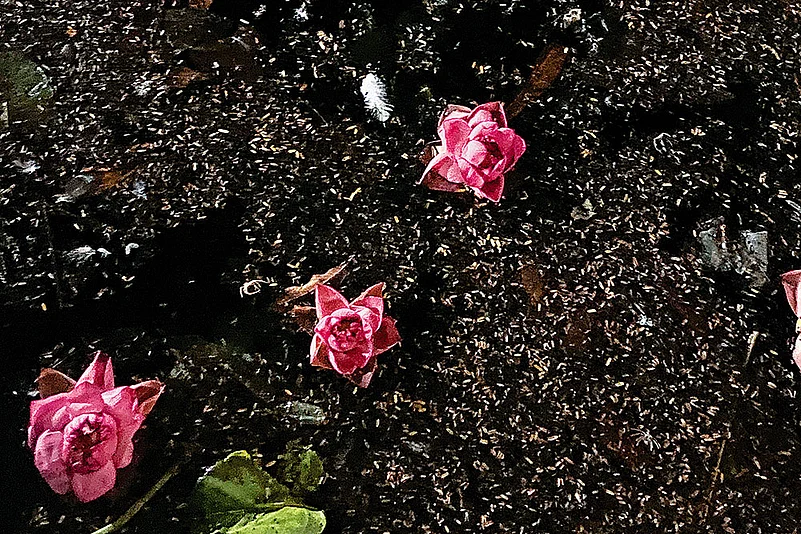Mist dawns in Patna, a city I skipped visiting until an unforeseeable future and is far from the city I belong to and one I am quarantined to by a stroke of luck. It is not even winter, but shivering is held in the photographs I browse and swipe up and down on a social media platform.
Quarantined, I saunter across the bridges to the world outside, built by others using photographs and odd news.
I stare at the smartphone screen. My friend and editor Chinki Sinha passes an empty billboard outside the city. Here, ‘Welcome’ is present in its invisibility. ‘Welcome’ is a word that births hesitation in this world harried bearing the pandemic wounds.
Sometimes I wonder why we peruse, stalk perhaps, record or seek truths in the personal annals of others available in public posts?
The social media posts does not cull boredom, but it works as a churner so that we do not freeze in our ennui. Sometimes, they even broaden our consciousness, open up our four corners, and we escape from our own brand of reality. They add dimensions to our sense of time and history. Perchance that way we eschew ruminating our own history.
This is the end of 2021. History fakes. The fakes become history. Time wears make-up, hides behind layers of readymade filters, and talks in newfangled acronyms of save itself.
Quarantined, I, a paper boat buoyant amidst the waves of life and the endings, muse my friend’s photographs. Their reality is two fold. One is perceived and presented by the one who posts them. The second belongs to the viewer who believes or distrusts them. The same rule applies to most of the entities and the concepts. Like the posts. Love those. Click on the sad or angry reactions the media platform provides. Every reaction or the lack thereof is a trigger of another chain of incidents or a thread in the unseeable future. In sooth, the importance of the reactions to something true equals the same to a hoax. The history in the era of social media is quicksilver. I chase the tiny and fast globules of ephemeral jiffies ere they disappear underneath the ever growing posts and comments, history and the building blocks we play with—time added to the bricks of time without any particular pattern, structure, or shape.
ALSO READ: Song Sung Blue: The End As A New Beginning

As if to observe the height of the arbitrariness I lift my head, turn, and a flight of dust-coloured doves paints my eyes with a dart of shadow. This is not my room. Again, I am inside the photographs. I breathe out smoke. The tea-stall I might always visit appears closed. One poster on the metal shutters claims, ‘Save Your Venereal Life’. Some shops, if found shut, abrade the sense of closure. Am I still in my room, not in Patna? Sure I am, and I travel with the photographs posted on someone else’s timeline albeit these scenes do not belong to any photograph my friend may have posted; imagination fills in the space in-between the images.
I swipe through the pond where an artist sketches many things except the pond, but we all know there ripples a pond in everything.
On the next stop I taste Chandrakala, the quiet sweet sweets made and piled up on a metal platter in a store by a busy street. It tastes a lot like baklava, labang latika, balushahi, flour, sugar syrup etc.
There stood a bookshop, a piquant one, magazines and text books kept it afloat, and made me believe serious literature can survive because of the commercial ones who rowed and rowed down the stream of demands. It is replaced by a dentist. Nothing odd happened. The business changes into a more pressing one, finds a new set of entrepreneurs someplace else, or sometimes in some other form.
I am stuck in someone else’s chronotope, but if I subsist in the same time-sphere, there is no ‘else’, and I should accept all in their entirety. Bakhtin’s observation of literary history does not see it as a catalogue of series of events, but as a “passage of time as a mountainside down which flowed, with an initially erratic and faltering momentum, an ever deepening, ever more forceful current of historical ‘becoming’, which, by the time it struck bottom, had become a torrent sweeping all before it.” (The Cambridge History of Literary Criticism, pages 143-154).
ALSO READ: The Four Horsemen Of Apocalypse

There is no ‘else’. Knowledge, in Peter Frederick Strawson’s logic, depends on perception; the idea is that perception is essentially a method of acquiring knowledge. Does knowledge, I wonder, affect perception, or do we grow knowledgeable according to the line of perception we have embedded in us? I do not know the details or the true narratives of the ‘fallen’ woman’s connection to the sacred shrine where her grave is situated. I whisper, ‘holy whore’ not out of disrespect, but quite contrarily, out of a solemn emotion, sense of poetry, and I bow in front of her grave, smell the limestone, crushed halm, spicy incense sticks of yesteryears, and dirt. The earth is fragrant by fame and obscurity. Do not tell me I cannot smell the abstract, ground the mounds of dirt while sitting hundreds of miles afar from the place. Where is it? In Sabalpur? Existence is generous, and it accommodates juxtapositions.
We coexist—I in my quarantine-room, and my friend gathering the cairns of some lesser known treasures in Bihar, the hidden truths.
ALSO READ: Meowdi: A Short Story by Perumal Murugan
One concern we nurse in our hearts is what we see in the media is a distortion. The other thought that niggles us inside is, the distorted pieces echo the candour, and we refuse to accept them because it hurts what we have learned.
Truth too is generous. Real and mythical parts form it.

The photographs and their commentary fall within the ‘Primary Sources’ of history, and believe me, truth has no qualms with your sources. It is with your belief that variety plays dice.
People are biased. The way they accept a friendship request they prefer and choose their narratives, but at the same time they befriend and desire to know the other side, even if just to keep an eye on the swing.
“Social media favours the quirky, the visual, the gruesome’” said Catherine Fletcher, a Professor of History, Manchester Metropolitan University and author of The Beauty and the Terror: An Alternative History of the Italian Renaissance (Bodley Head, 2020). Thus, I do not think the social media posts are different from the ancient gossip and dramatic representations—recall Chaucer—or than the more modern tabloids. We tend to see time through a kaleidoscope of colliding violent coloured glass-shards, and perhaps, the movement keeps the time fluid. And nothing represents time like a gravestone.
ALSO READ: Gods, Bots And The New World Order
I apologise for wandering. I zoom in on the photograph, the one of the grave of Allah Jilai Bai—described my friend and wrote that someone told, she was a ‘tawaif’. The epitaph says a few words of silence. The epithet echoes around the shrine and the ruins.
Another photo displays ‘Kachchi Dargah’. The absence of any concrete structure seems to ease the divine ingress and egress.
Now I can hear the ting and the clutter of heavy ornaments. Now nothing. Now I witness the supreme entity. Now darkness enshrouding all details. Now I comprehend the history, and now I stand in the nowheresville following the coordinates of loss.
In some photographs poverty is scattered throughout Bihar, and sometimes from the distance looks Raj Kapoor-romantic, and then I imagine hundreds of miles a migrant worker crossing, falling asleep never to walk again. Everything is blowing in the wind.
I click, and the screen drowns into black.
ALSO READ: The Good Earth: Resilient And Resourceful
Mundane should not be ignored in the grand theory of defining and classifying civilization. In his From Popular Culture to Everyday Life, John Storey failed to define ‘Everyday Life’, and acknowledges that there exists ‘enormous difficulties’ in defining ‘something that is so taken for granted.’
Dear friends, recording your mundane and sharing those with us is extraordinary. Your witness-posts do not depend on the acceptance or refusal, interpretation or mere browsing-passing. According to Harold A. Innis, communication tends to change political, juridical, religious and economic structures, and vice versa, and especially the empires—or the monopoly of power depends on the communication.
***
The epitaph on the tombstone of Allah Jilai (1337 Hijri/1919 AD). Translated from the original in Urdu
This is the strange and painful tale of Allah Jilai
If you pay close attention, these are all miracles of love
As she arrived in Azimabad from Allahabad,
her singing and beauty became the talk of the town,
At the prime of her youth, pinnacle of charm,
her personality was discussed by the entire populace,
The way she often smiled with grace and pride,
the pomp and style that she carried with herself
Words fail me as I try to narrate her story
there were so many aspects to her persona
She had attained unparalleled success in her profession,
So much was yet to be enjoyed of her hard-earned wealth,
But alas! she brought such a disease with her from Calcutta,
Her health was already on the wane as she returned here,
It was the 11th day of the month of Rajab
that the day of reckoning arrived,
This fairy-face had seen only 24 years in her life
Was this any age to die?
or the time to enjoy oneself,
The blooming flower of this garden
dried off at its prime without seeing the world
and nothing was left except to mourn,
Oh Lord! not just sinners but even unbelievers
eventually trust in the power of your forgiveness
It is with a cold heart that I tell this tale and pray to you
Please grant her a place in a corner of heaven.
(This appeared in the print edition as "Through The Eye Of The Third Kind")
(Views expressed are personal)
ALSO READ
Kushal Poddar is former editor of the Words Surfacing magazine, and an author


























